The first Madrid derby of this La Liga campaign was played on Sunday. Carlo Ancelotti’s Real Madrid found the net twice and took all three points against Atletico Madrid at the Santiago Bernabéu. Although this was not the most entertaining game from the goal threat perspective, tactically, it was a great battle between “El Cholo” and Carletto. This tactical analysis will explain how Madrid took control of the game and put in a more convincing performance despite the xG of both sides being 0.55.
Lineups
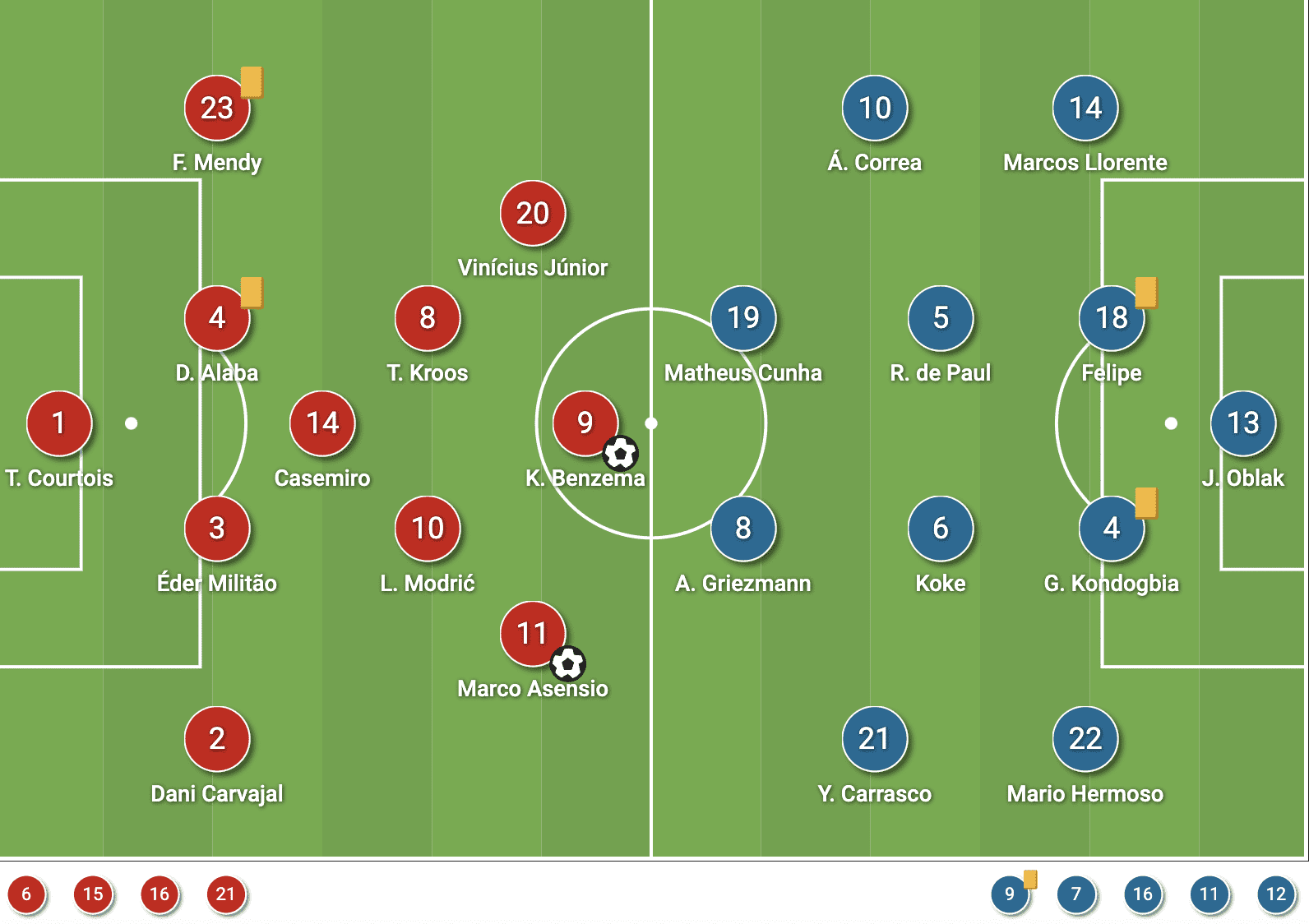
Real Madrid only had minimal changes after winning the UEFA Champions League game against Inter. Rodrygo and Luka Jović started on the bench as Karim Benzema and Marco Asensio returned to the lineup. The rest were the same players who started in the midweek fixtures, and the 36-year-old Luka Modrić must be appreciated for his successive high-level performance without much rest.
Although Simeone played his team in a 3-4-2-1 against Porto, he reverted to a more conservative 4-4-2 formation away from home. An interesting point to note was the proper full-backs: Kieran Trippier and Renan Lodi were not starting. Marcos Llorente and Mario Hermoso were filling these positions, they formed the backline with Felipe and Geoffrey Kondogbia.
Madrid’s positional structure
Offensively, Ancelotti was not receiving enough praises this season. While all eyes were watching the great individual displays from Benzema and Vinícius Júnior, people forgot the guy who gave the players confidence and rooms to perform was the coach behind. Carletto had a lot of experiences with this squad previously, he knew the players well, and the structure he designed allowed each player to exercise the strengths.
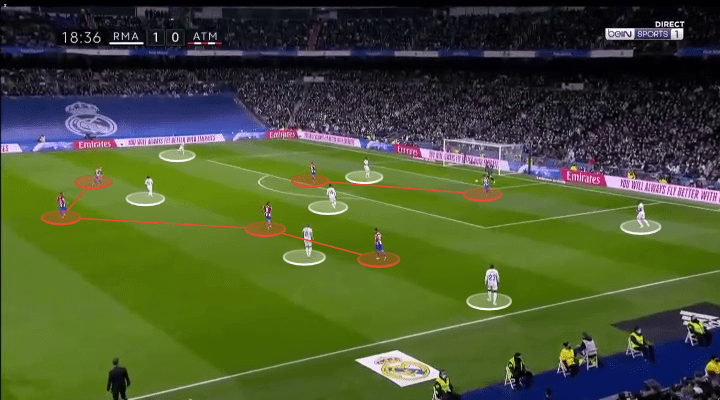
In the build-up, Madrid played with seven deep players plus a goalkeeper to generate a 8v6 numerical advantage over Atlético’s 4-4-2 defence. To establish this superiority, they needed the front three to stay high to fix the last line, so the opposition block was stretched vertically. The above image shows the situation, Madrid hold a pair of wide full-backs to obtain the widths in their third, this gave them a lateral switch option when the opponents pressed high. Also, the 6 (Casemiro) rarely dropped as they wanted to create more spaces for the centre-backs.
Atlético defended in a 4-4-2, but could also be interpreted as a 4-1-3-2 as they planned to have a midfielder covering the front five. The priority of the defence was to close the centre to make sure Madrid could not play inside them, so the wingers were staying inward in the block initially. Then, they could press with the strikers but the duo should keep an eye on Casemiro alternatively, but that also suggested they inevitably had a 2v4 deficit, unless one of the midfielders joined the press higher to form a 3v4.
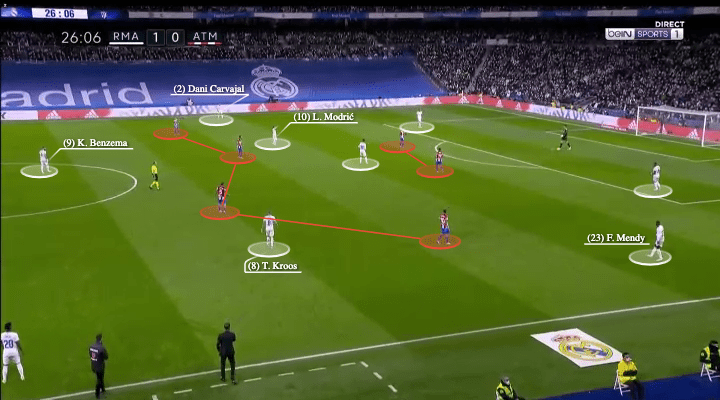
However, as explained, given Madrid utilized the widths of the pitch, it made Atlético difficult to press them high. The strikers were always late to arrive on the receiver, and this gave the hosts room to evade the press. We can see more build-up structures through the above image. Again, Ferland Mendy and Dani Carvajal were staying wide to stretch the second line, this would give Madrid more spaces in the centre.
Initially, the Atlético strikers were covering Casemiro, but then they would be late to close down Éder Militão. Apart from that, you could see the intelligent positionings of Madrid midfielders as Modrić and Toni Kroos were staying in both half-spaces to stretch the 6s of Atlético. To exploit those spaces behind the Atlético midfield, they had Benzema dropping deeper though Thibaut Courtois was not an expert of lofted passes.
To sum up Atlético’s defensive issue, it was a block of six, and the other four. The last line was detached from the rest and that hindered their pressing, players were without cover and the spaces were too big to defend.
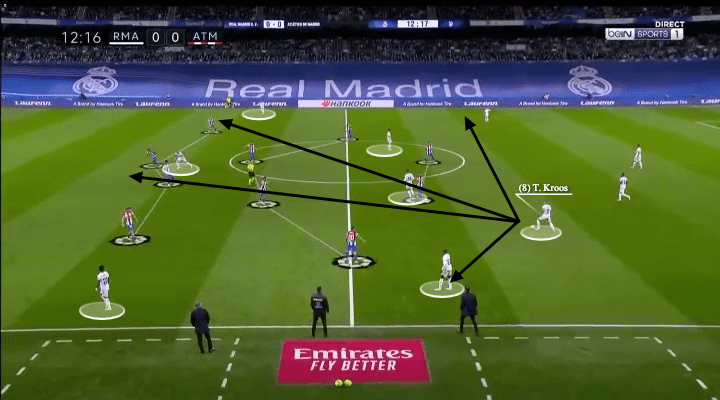
Apart from the build-up, Madrid were also controlling the game in the middle third. In that phase, El Cholo’s troops would drop into a 4-4-2 midblock, the compactness and intensity were better as well. The trigger was clear, when Madrid made a square pass or a backward pass in the midfield, the Atlético midfielders should step up vertically to block the space of the receiver. This was also a strategy to make sure Madrid were not playing inside them, and thus, forcing the attack sideways. But note that if the receiver was outside of the Atlético formation, then, the initial presser shall drop back to cover spaces as they were avoiding being stretched.
Madrid were clever and they were a difficult to team to defend as the midfielders had exceptional passing quality. Specifically, Kroos played a deeper role in the left half-spaces in this game to dictate outside of the formation. The German international had a crazy passing range to generate dynamics in the attack. For example, he has the ability to access the striker behind, the full-back and winger on the opposite flank, or Mendy in the diagonal direction when the ball was on his feet. That means the opposition could only keep guessing if they could not apply pressure on Kroos. It was uneasy as Mendy’s position was usually corresponded to Ángel Correa’s defensive behaviours, so Kroos formed a 3v2 with Madrid centre-backs to overload the strikers of Atlético.
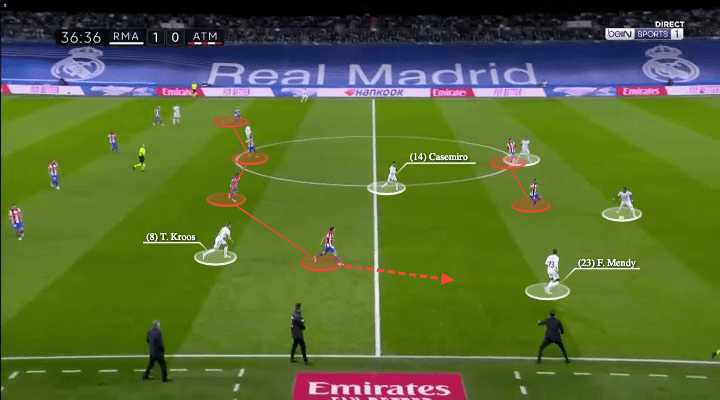
But the previous example was not the only way of Madrid’s game, Ancelotti gave his players the freedom to roam and use spaces as they were clever enough to do so. In the above screenshot, Madrid had a slightly different shape but still dictated the flow of the attack.
This time, Mendy was deeper to offer an option for David Alaba. While Casemiro was operating between the lines, trying to lure Rodrigo de Paul out, Kroos was lurking behind Correa. If the Argentine attacker moved out to press Mendy, Alaba was provided with a vertical passing option in half-spaces, or if de Paul moved wider, Casemiro could only be covered under Matheus Cunha’s shadow. It was also attributed to Atlético’s inability to close spaces around Kroos as the last line was fixed by Madrid’s front three.

Atlético had a decent 4-4-2 to defend in their own half, they denied Madrid from creating a lot of huge chances, they only conceded six shots in this game, so the defensive performance was not too bad at all.
It was the same principle, the players needed to maintain the intensity in the centre, which means they should step up and narrow the angle when Madrid were moving the ball. For example, de Paul pushed higher to press and force Kroos to pass here, as the strikers were fixed by Casemiro in the central channel. Then, to close that space behind the midfielders, Atlético centre-backs must step up to follow the Madrid roaming players as Felipe did above. You could also see the guests were ready to press. When Kroos found Mendy, Correa was ready to jump onto the left-back diagonally, and he was covered by the right-back. When Madrid receivers were confronting pressure, they would not risk and they shall went back all the way to reorganize, Atlético did not let them in easily.
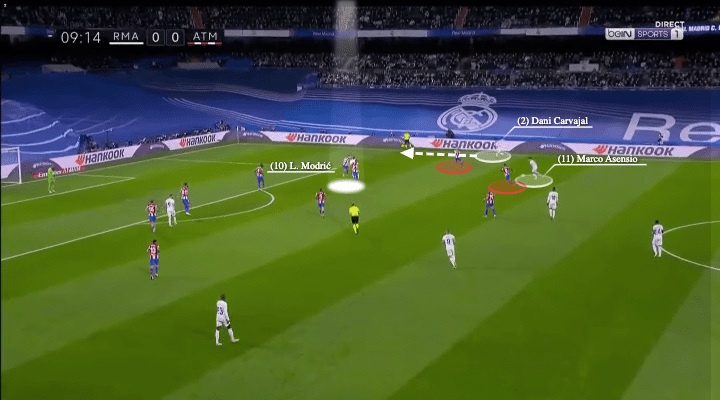
On the left side, Madrid relied on the quality of Vinícius to take on the opposition or involve Benzema in the positional interchanges. On the right side, they had less 1v1 individual quality but there was another way to attack. Apart from using Carvajal/Asensio to hold width and attack from the flanks, they needed Modrić’s intelligence to pin the oppositions in the advanced area to open spaces. In the derby, the Croatian midfielder always appeared in higher spaces to fix the opponents. For example, his presence kept two Atlético defenders around and created a 2v2 situation for Carvajal and Asensio to advance on the right side.
But Madrid’s offensive organization usually slowed down when reaching the final third. Without a player constantly occupying the centre-backs after Benzema left his position, they were unable to deliver early crosses before the opponents got back to positions.
Direct Atlético
Comparatively, Atlético played in a more direct way, but the outcome was below El Cholo’s expectation. Especially in the first half, there were something missing and they only generated 0.11 xG from three shots.
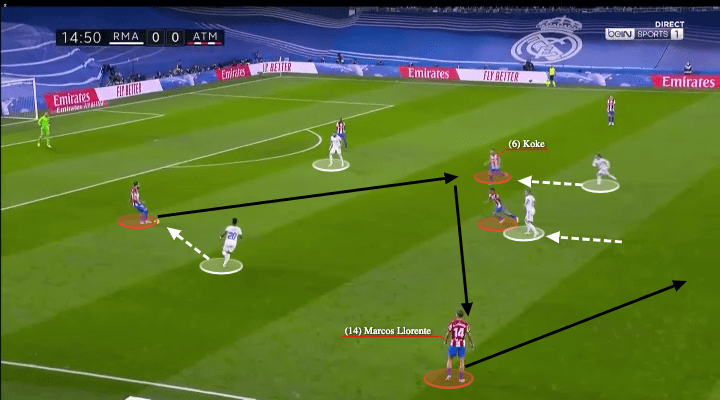
Atlético only had 164 passes and 37.26% of possession in the first half, they could not keep the ball or even giving it away recklessly. They played with a 4-2 shape in their half, dragging the opposition up with two deep midfielders. Specifically, when they used the wingers to fix the last line of Madrid, the full-backs shall enjoy more spaces to receive when the Madrid wingers pressed centre-backs. Here, Vinícius went to Felipe, and Atlético escaped by using Llorente as the third man to transit. Since Mendy would be late to close the right-back, it was possible to play a one-two with the support in half-spaces and Atlético went out on the right side a lot.
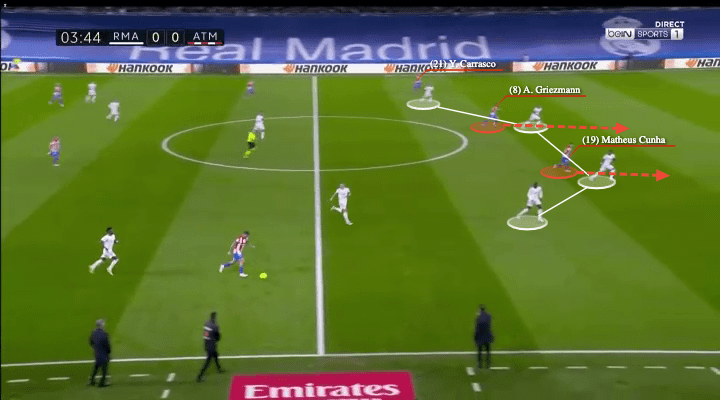
In higher areas, it was important for Atlético to go behind as they had good conditions theoretically. In their 4-4-2, Antoine Griezmann and Cunha were matching the centre-backs, that was a 2v2 or two 1v1 and it was possible to create isolations and separations through coordinated movements. The strikers were lacking chemistry and they could not capitalize on these situations enough.
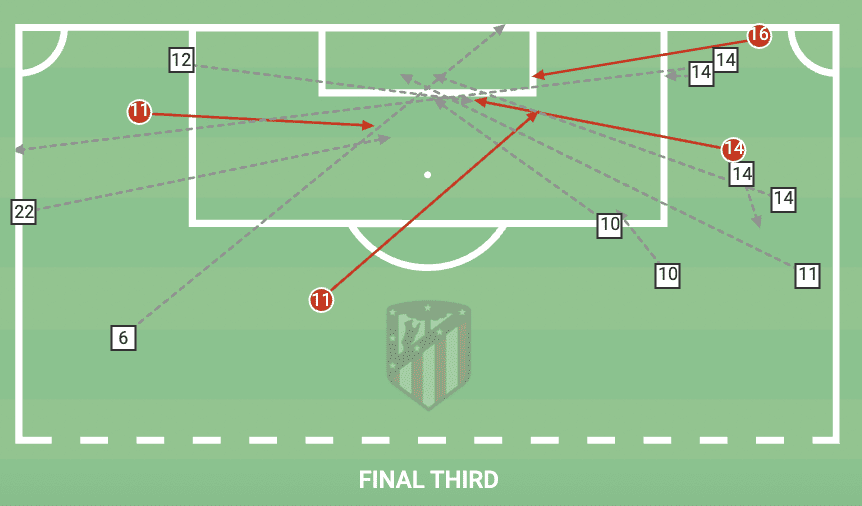
Another important missing part of the attack was Yannick Carrasco. Surprisingly, the Belgium left-winger was very quiet in the derby and people almost forgot his existence. Of course, Madrid had good ways to defend against the qualitative wingers but Carrasco did not do enough. The above image shows Atlético’s all 14 crosses (cr. Wyscout), and only one of them came from Carrasco in the first 45. Comparatively, Thomas Lemar had two more than him in the other half.
Since Carrasco only posed a minimal threat in this game, Carvajal had a relatively easier job to do. The Madrid right-back could pay more attention to his centre-backs and moved inward earlier to make it a 3v2. That was another reason for the unsuccessful use of two strikers against two centre-backs.
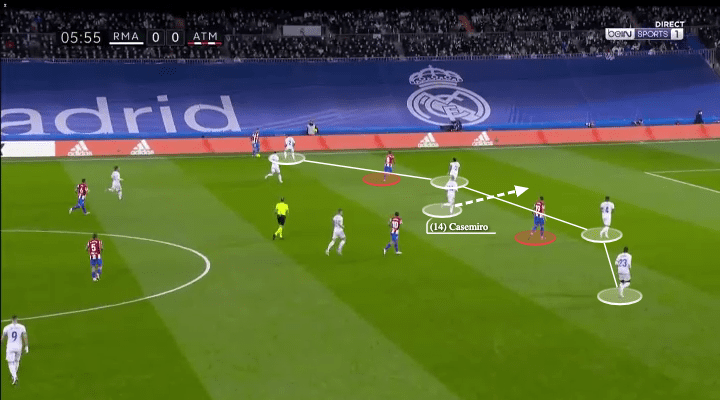
In addition, Madrid had Casemiro to provide additional protection to the last line, which also ruined Atlético’s offensive plan. When Carrasco dragged Carvajal out to the wide spaces and stretched the defence in the above situation, Griezmann also made a forward run to separate Militão from Alaba. Then, Cunha should have a 1v1 opportunity to exploit spaces around Alaba, but that advantage was nullified as Casemiro was alert to cover that gap between the centre-backs.
Working together & controlling the game
Atlético were one goal down during halftime as Benzema showed his class again. Simeone made two changes by using João Félix and Thomas Lemar to replace Griezmann and Carrasco. However, they were unable to solve the low block of Madrid as Ancelotti’s men were really disciplined.
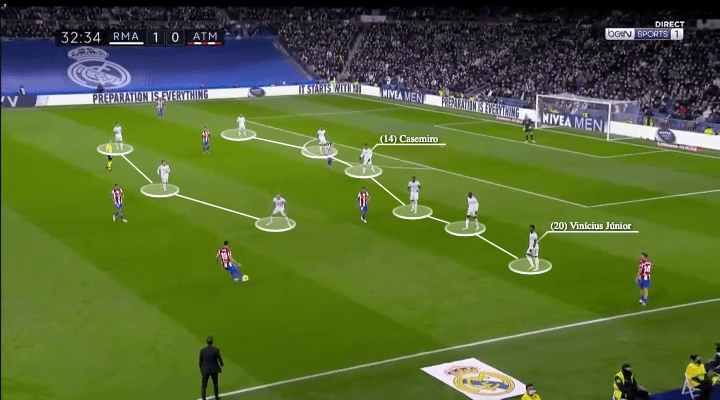
Carletto’s team was good at playing in a low block, to drag the oppositions out and hit them on the counters. Specifically, they put nine men behind the ball and left Benzema high as the rest offence, as we showed in the above image. At times, the shape was a 6-3-1 and it was important to have wingers helping the full-backs in the wide spaces, and Casemiro dropping into the last line to give an additional man. With players to form the last line, the channels between each defender were narrowed as much as possible and that made Atlético difficult to play through them.
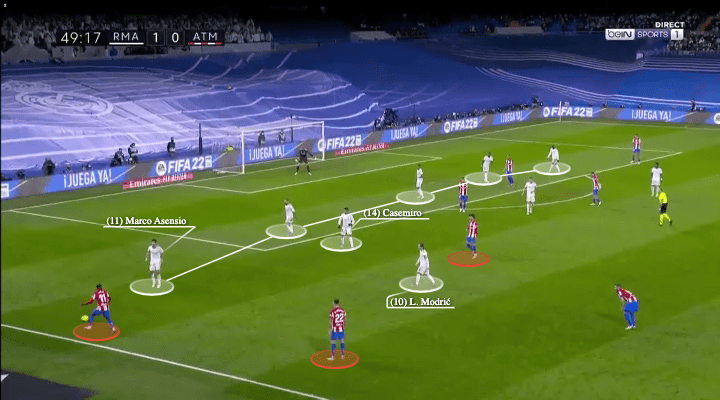
In the second half, Lemar and Félix carried great responsibilities in the attack and the duo combined a couple of times on the left side. However, Madrid had really great defensive structure to nullify the attacks of Atlético. Here, in this image, you could see Lemar was without any support as Hermoso was not good at attacking the outside spaces, the winger must dribble on his own without much help. Furthermore, Madrid’s backline was completed as Asensio came back to cover the wide spaces for Carvajal, which made sure the hosts had enough players to defend the two strikers in the centre. Carletto’s troops also had Modrić and Casemiro around to lock the half-space around Félix and the ball, the players were staying close to each other so they could support and cover at any time.
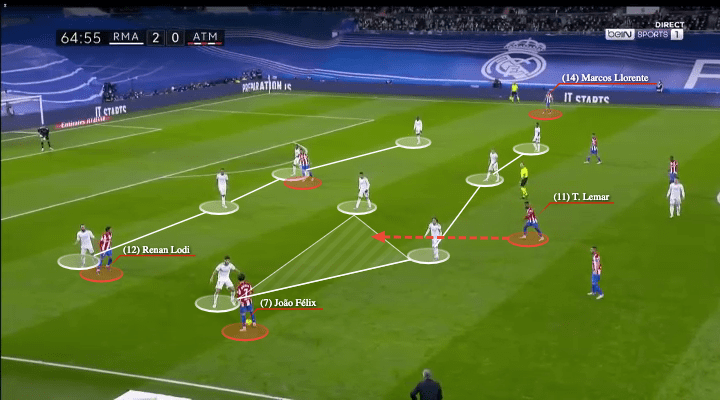
Another issue of Atlético was the use of Felix. Simeone played Lodi at the hour mark to inject the offensive force on the left side. Now, the Brazilian international and Llorente hold the widths on both sides and freed Lemar to roam centrally. However, they also moved Félix out of the centre and the penalty zone as the former Benfica man tended to receive from deep so that he could turn and face the opposition goal with more space. But that also loosed Madrid’s defence a bit, which you could see from the above analysis. Although Lemar could move into spaces to receive a lateral pass from Félix, Casemiro could step up to cover. Madrid played in a 4-1-4-1 defensive shape in the image as Atlético only had one striker against two centre-backs in the frontline, so they also attracted Casemiro’s pressure in the midfield.
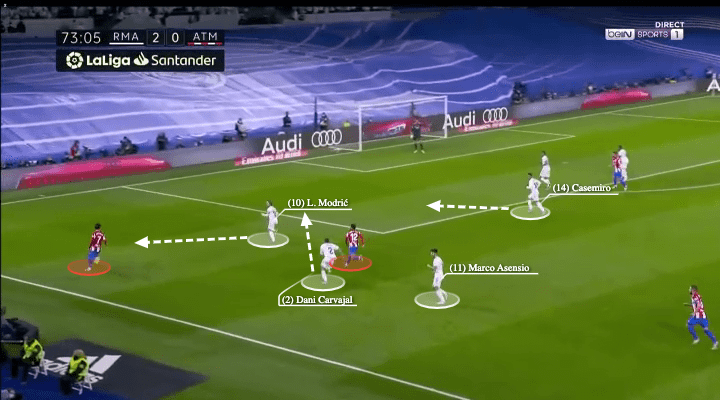
Again, this was a great example of Madrid’s wide defending and how that shut the attack. Félix had the ball on the wide spaces, and you could see the 10, the full-back, and the winger were always together to defend. Although Lodi made a forward run to support, Modrić and Carvajal knew they should go man-man and there was a 3v2 numerical advantage with Asensio cutting the backward passing lane.
Or, hypothetically, even Lodi received behind Modrić and Carvajal could not track, Madrid could still be safe as Casemiro was there to cover, once against it shows his importance to the protection of the last line.
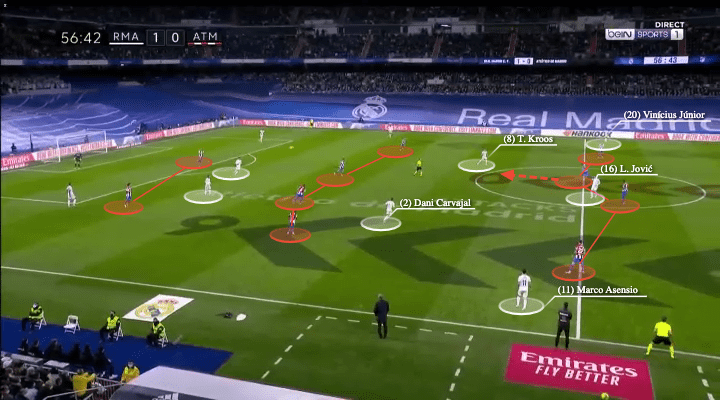
Another important part of the game was the Asensio goal, the goal helped Madrid to kill the game and the moment was critical, it was right before the second wave of Atlético changes. Lemar and Félix came in early and they might change the offensive structure a bit, but the defensive problems remained in Atlético’s high press.
The above scenario shows the situation before the second goal. You could see, Madrid played in a similar way by using two deep midfielders to drag the Atlético midfielders high. Then, Vinícius, Jović, and Asensio stayed high and wide to push the last line deep, and the guests were unable to close spaces between the second and last line. In that 4-4-2, Kroos and Carvajal enjoyed a lot of rooms behind de Paul and Koke. When Madrid lofted the ball in the midfield, the centre-back was forced to come out to press Kroos, and that resulted in a 3v3 or three 1v1s in the Atlético half, that was Madrid’s strength and Simeone’s men could not deal with that quick attack.
Conclusion
“My team reassures me because I know what they can do out on the pitch. They manage the game very well, they’re very committed defensively… they’re a team.” – Ancelotti
Madrid looked like a team with a high confidence level in the derby. Despite not being consistently generating big chances in the final third, they gained an upper hand thanks to Benzema’s quality. Also, the rhythm they had was comfortable and fresh, and that gave them control of the game, they dictated. Ancelotti should be happy to see the performance of his troops.
Simeone would not be satisfied with his side’s performance, and he admitted it was a fair victory to the opposition. He knew where the game was lost and there are 22 more games to play. If the likes of Félix and Griezmann could be more consistent or recover their best form, this Atletico Madrid would be more clinical in front of the goal and had more flexibility in the tactics.




Comments